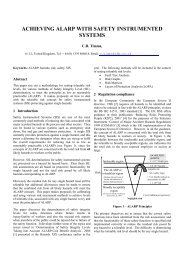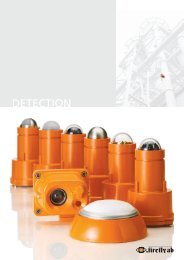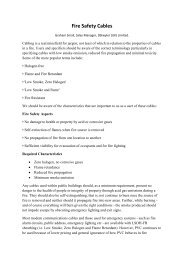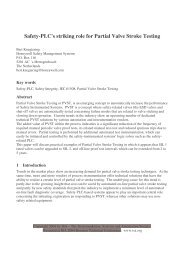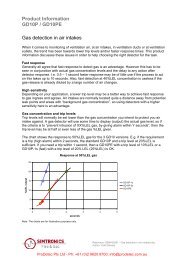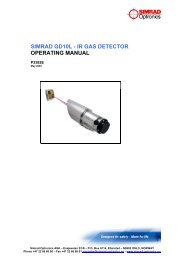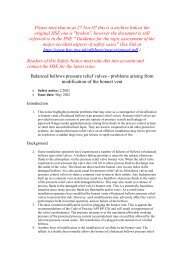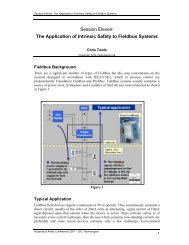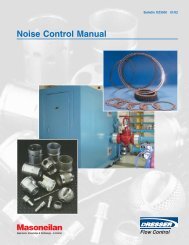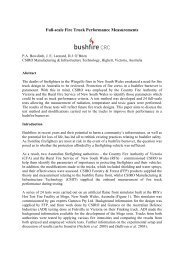Programmable Safety Systems for Burner Management on ... - ICEWeb
Programmable Safety Systems for Burner Management on ... - ICEWeb
Programmable Safety Systems for Burner Management on ... - ICEWeb
- No tags were found...
Create successful ePaper yourself
Turn your PDF publications into a flip-book with our unique Google optimized e-Paper software.
<str<strong>on</strong>g>Programmable</str<strong>on</strong>g> <str<strong>on</strong>g>Safety</str<strong>on</strong>g> <str<strong>on</strong>g>Systems</str<strong>on</strong>g> <str<strong>on</strong>g>for</str<strong>on</strong>g> <str<strong>on</strong>g>Burner</str<strong>on</strong>g><str<strong>on</strong>g>Management</str<strong>on</strong>g> <strong>on</strong> Gas Turbines.As the demand <str<strong>on</strong>g>for</str<strong>on</strong>g> energy throughout Australia increases the demand <str<strong>on</strong>g>for</str<strong>on</strong>g> alternativesources is increasing accordingly. The use of gas turbine generati<strong>on</strong> to supply smallto medium requirements is becoming increasingly popular.The principles of Safe <str<strong>on</strong>g>Burner</str<strong>on</strong>g> <str<strong>on</strong>g>Management</str<strong>on</strong>g> in typical gas Boiler/<str<strong>on</strong>g>Burner</str<strong>on</strong>g> applicati<strong>on</strong>sare equally relevant to Gas Turbines. Many existing Turbines in Australia wereinstalled prior to current standards and regulati<strong>on</strong>s and in many cases using traditi<strong>on</strong>alHard Wired c<strong>on</strong>trol systems. As these c<strong>on</strong>trol systems are being upgraded withcurrent technologies such as PLC’s and DCS’s special attenti<strong>on</strong> must be paid toensure regulati<strong>on</strong>s are complied with.A practical example of what is required occurred when a new gas generati<strong>on</strong> plantwas installed recently in the Latrobe Valley. 20 year old Gas turbines were broughtover from New Zealand with an upgraded c<strong>on</strong>trol system being designed and installedby an overseas based company. Although the upgrade was using a modern highquality PLC based c<strong>on</strong>trol system it was realised that this system was not approved<str<strong>on</strong>g>for</str<strong>on</strong>g> use in Australian Gas applicati<strong>on</strong>s under the codes AS3814-2002/AG501.It was decided that an approved supervisory PLC system would be installed inc<strong>on</strong>juncti<strong>on</strong> with the n<strong>on</strong> approved c<strong>on</strong>trol system. The following paper discusseshow the system was implemented and the required compliance was achieved.Principles of Gas Turbine Operati<strong>on</strong>:As with c<strong>on</strong>venti<strong>on</strong>al burners, gas turbines must follow the same gas safetytechniques required by AS3814-2002/AG501. This safety process includes Purging,Valve positi<strong>on</strong> proving, ensuring correct igniti<strong>on</strong> (Light Off) and c<strong>on</strong>tinuous flamem<strong>on</strong>itoring. Whilst some of these processes are the same in Gas Turbines as Boilers,the way in which they are achieved can be different.The turbine start commences when a compressed air starter is used to spin theturbine up to a set speed of 1500RPM. Once this speed is reached a 30 sec<strong>on</strong>d purgebegins. The 1500 RPM set point must be proven to be maintained <str<strong>on</strong>g>for</str<strong>on</strong>g> the full 30sec<strong>on</strong>d period to ensure the correct volume of air has purged the system. At the endof the purge cycle the valves are opened and a spark ignites the gas. Compressed airis removed and the exhaust from the burning gas now drives the turbine. Igniti<strong>on</strong>must now be proved; c<strong>on</strong>venti<strong>on</strong>al techniques such as flame detectors are not viable<strong>on</strong> a turbine so another speed set point is used. The turbine must now reach a newhigher speed level (2300 RPM) within a set time of 15 sec<strong>on</strong>ds. This set point provesthat the gas has ignited as the 2300 RPM is well over the maximum speed attainableby the air starter, this igniti<strong>on</strong> is termed “Light Off”.
The Turbine is now run up to its operati<strong>on</strong>al speed with a modulating gas valve beingc<strong>on</strong>trolled by the standard PLC c<strong>on</strong>trol system. The <str<strong>on</strong>g>Safety</str<strong>on</strong>g> system is now m<strong>on</strong>itoring<str<strong>on</strong>g>for</str<strong>on</strong>g> loss of flame known as Flame Out and other c<strong>on</strong>tinuous c<strong>on</strong>diti<strong>on</strong>s which will bedescribed in the following secti<strong>on</strong>s.In the described applicati<strong>on</strong> two turbines (A and B) are c<strong>on</strong>nected at each end of theGenerator in what is called a “Twin Pack” arrangement. Air Coupling from theTurbine to the Generator allows the turbines to operate singly at half power ortogether. Each turbine is capable of producing 25MW, there<str<strong>on</strong>g>for</str<strong>on</strong>g>e a 50MW capacity isavailable from each Generator set.<str<strong>on</strong>g>Safety</str<strong>on</strong>g> System Descripti<strong>on</strong>:A Pilz <str<strong>on</strong>g>Programmable</str<strong>on</strong>g> <str<strong>on</strong>g>Safety</str<strong>on</strong>g> System (PSS) was chosen as the supervisory safety PLCas it provided the technical requirements, was cost effective and is approved <str<strong>on</strong>g>for</str<strong>on</strong>g> useby TUV as specified by AS3814-2002/AG501. A 5 Slot PSS 3100 rack was used <strong>on</strong>each of the 6 turbines. Each PSS3100 was c<strong>on</strong>figured with 48 Digital Inputs, 16Digital Outputs, 12 Relay Outputs, 6 x 4-20 mA analogue inputs and 6 x –10 to +10Vanalogue inputs.Fig.1 Gas Valve Layout
<str<strong>on</strong>g>Safety</str<strong>on</strong>g> System Operati<strong>on</strong>al Requirements and Implementati<strong>on</strong>:Figure 1 shows the layout of the valve system which is duplicated <str<strong>on</strong>g>for</str<strong>on</strong>g> each turbine <strong>on</strong>a Twin Pack. The Main Shut off Valve is located <strong>on</strong> the Gas Skid and provides aprimary isolati<strong>on</strong> point <str<strong>on</strong>g>for</str<strong>on</strong>g> the turbine, it is closed if an Emergency stop c<strong>on</strong>diti<strong>on</strong>results and when the Turbine is not in operati<strong>on</strong>. The Shut Off Valves (SOV) SOV1and SOV2 provide a redundant means of isolating fuel from the Turbine and provideprimary protecti<strong>on</strong>. The Modulating Valve (MOD) c<strong>on</strong>trols fuel flow to the Turbine<str<strong>on</strong>g>for</str<strong>on</strong>g> speed c<strong>on</strong>trol.The PSS has the final shutdown c<strong>on</strong>trol of the system. The PLC is the primaryc<strong>on</strong>trol system and works in c<strong>on</strong>juncti<strong>on</strong> with a sec<strong>on</strong>dary c<strong>on</strong>trol system called SPC.The following points describe the PSS operati<strong>on</strong> <str<strong>on</strong>g>for</str<strong>on</strong>g> the complete turbine cycle.Depending <strong>on</strong> the c<strong>on</strong>diti<strong>on</strong> either a single Turbine may be shut down, which is calledan 86Ex trip where x is the A or B unit. Other c<strong>on</strong>diti<strong>on</strong>s require the complete TwinPack to be shut down in an emergency stop type c<strong>on</strong>diti<strong>on</strong> which is called an 86GX/Y trip.1. Valve Leak Test.At commencement and finish of each run a valve leak test is per<str<strong>on</strong>g>for</str<strong>on</strong>g>med. Two Pressureswitches (PS) are installed between SOV1 and SOV2. At start up the Main SOV isopened whilst SOV1 remains closed. A low pressure switch between SOV1 andSOV2 checks <str<strong>on</strong>g>for</str<strong>on</strong>g> SOV1 Leakage <str<strong>on</strong>g>for</str<strong>on</strong>g> a 15 sec<strong>on</strong>d period. SOV 1 is now opened topressurise the chamber between it and SOV2. SOV1 then closes and the chamber isthen proven to maintain pressure <str<strong>on</strong>g>for</str<strong>on</strong>g> 15 sec<strong>on</strong>ds by a high set pressure switch . Thistests the integrity of SOV2. During the test the LVDT of the MOD Valve ism<strong>on</strong>itored c<strong>on</strong>tinuously as a further test of the integrity of SOV2. A failure of theleak test shuts down a single turbine with an 86Ex Trip.Fig 2. Temperature Protecti<strong>on</strong>.
Temperature protecti<strong>on</strong> (Fig. 2) c<strong>on</strong>sists of a number of start up and c<strong>on</strong>tinuous teststhroughout the turbines operati<strong>on</strong>. Primary protecti<strong>on</strong> is provided by two sets ofthermocouples mounted in the exhaust case of the turbine. The thermocouples arem<strong>on</strong>itored by the SPC and PLC. The critical stages of the process that can cause overtemperature, being the correct burning process are m<strong>on</strong>itored by the PSS inc<strong>on</strong>juncti<strong>on</strong> with the other c<strong>on</strong>trol systems.1. PurgeOnce the valve leak test has completed successfully a Purge Step commences. Aminimum turbine speed of 1500 RPM must be maintained <str<strong>on</strong>g>for</str<strong>on</strong>g> 30 sec<strong>on</strong>ds to evacuateany unburnt fuel from previous runs.2. Light OffAfter the Purge, SOV 1 and 2 open and the modulating valve allows gas to flow. Aspark ignites the gas. A successful Light Off has occurred if the Turbine speed isdriven up by the exhaust gases to a set speed of 2300 RPM in 10 sec<strong>on</strong>ds. The PLCand SPC also detect light off by comparing temperature rise over time providing threeindependent and diverse proofs.Fig 3. Modulating Valve M<strong>on</strong>itoring.
3. Flame OutOnce Light Off is proven a number of c<strong>on</strong>tinuous m<strong>on</strong>itoring c<strong>on</strong>diti<strong>on</strong>s take place<str<strong>on</strong>g>for</str<strong>on</strong>g> the durati<strong>on</strong> of the Turbine’s operati<strong>on</strong>. The first of these is m<strong>on</strong>itoring <str<strong>on</strong>g>for</str<strong>on</strong>g> FlameOut. The PSS m<strong>on</strong>itors <str<strong>on</strong>g>for</str<strong>on</strong>g> this by comparing the rate of change of the MOD Valvespositi<strong>on</strong> over time. In a Flame Out c<strong>on</strong>diti<strong>on</strong> the MOD valve will open far morequickly and over a larger angle than during normal running as it tries to maintainTurbine speed.4. Gas Pressure and Flow.A Flow Transducer is used to m<strong>on</strong>itor the Gas Flow c<strong>on</strong>tinuously. If the flowexceeds a certain limit an 86 GX/Y trip occurs. This is to detect gas escaping due tocatastrophic failure or rupture of the line.A Gas Pressure Transducer m<strong>on</strong>itors <str<strong>on</strong>g>for</str<strong>on</strong>g> over pressure which can result in a poor airto fuel mix. An 86Ex trip occurs in such a situati<strong>on</strong>.5. Gas Leak Detectors.Gas leak detectors are installed in the Turbine enclosures to detect any gas build up.An 86 GX/Y trip occurs if gas is detected.Fig. 4 Air Flow and Gas Detecti<strong>on</strong>.
6. Sec<strong>on</strong>dary Air Switches.As a protective measure in case of gas leakage the Turbine enclosures are ventilated.The air flow from the enclosure is m<strong>on</strong>itored by a pair of positi<strong>on</strong> switches attachedto exhaust flaps which are wired to the PSS and the PLC. These switches are provento operate correctly at each fan start stop.Fig 5. Speed M<strong>on</strong>itoring.7. Turbine & Generator Speed M<strong>on</strong>itoring.The Turbine speed (N2) and Generator speed (N3) are m<strong>on</strong>itored redundantly withanalogue signals being transduced by a Dynalco transducer and SPC speed c<strong>on</strong>troller.The Dynalco’s signal is fed into the PSS and the PLC. An over speed c<strong>on</strong>diti<strong>on</strong> shutsboth Turbines down with an 86GX/Y trip.
C<strong>on</strong>clusi<strong>on</strong>:Just as Standard PLC’s have become comm<strong>on</strong> place in Industry over the last twentyyears, <str<strong>on</strong>g>Programmable</str<strong>on</strong>g> <str<strong>on</strong>g>Safety</str<strong>on</strong>g> <str<strong>on</strong>g>Systems</str<strong>on</strong>g> or <str<strong>on</strong>g>Safety</str<strong>on</strong>g> PLC’s are now becoming standardequipment in Australia as end users and system designers are become aware of theengineering and cost advantages.By using a <str<strong>on</strong>g>Programmable</str<strong>on</strong>g> <str<strong>on</strong>g>Safety</str<strong>on</strong>g> System, the 20 year old Turbine Generators wereable to be brought up to current safety specificati<strong>on</strong>s with the benefits of modern PLCtechnology. Diagnostic in<str<strong>on</strong>g>for</str<strong>on</strong>g>mati<strong>on</strong> was communicated to the plant SCADA via aModbus link which enables operators to view safety system status from the c<strong>on</strong>trolroom located remotely.Written By:Justin Farrell B.Eng.(Elec.)Product Manager.<str<strong>on</strong>g>Programmable</str<strong>on</strong>g> <str<strong>on</strong>g>Safety</str<strong>on</strong>g> <str<strong>on</strong>g>Systems</str<strong>on</strong>g>.Pilz Australia.




